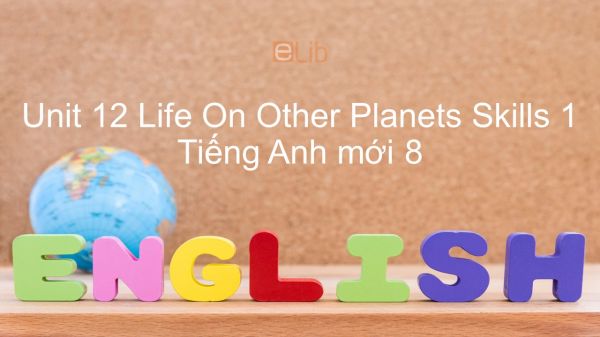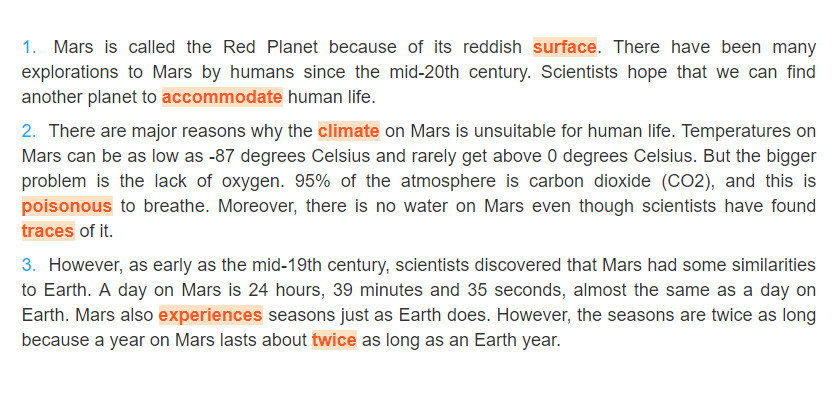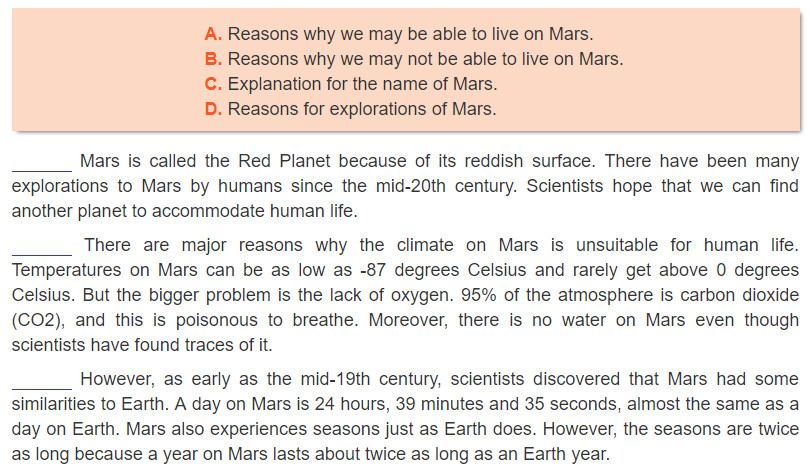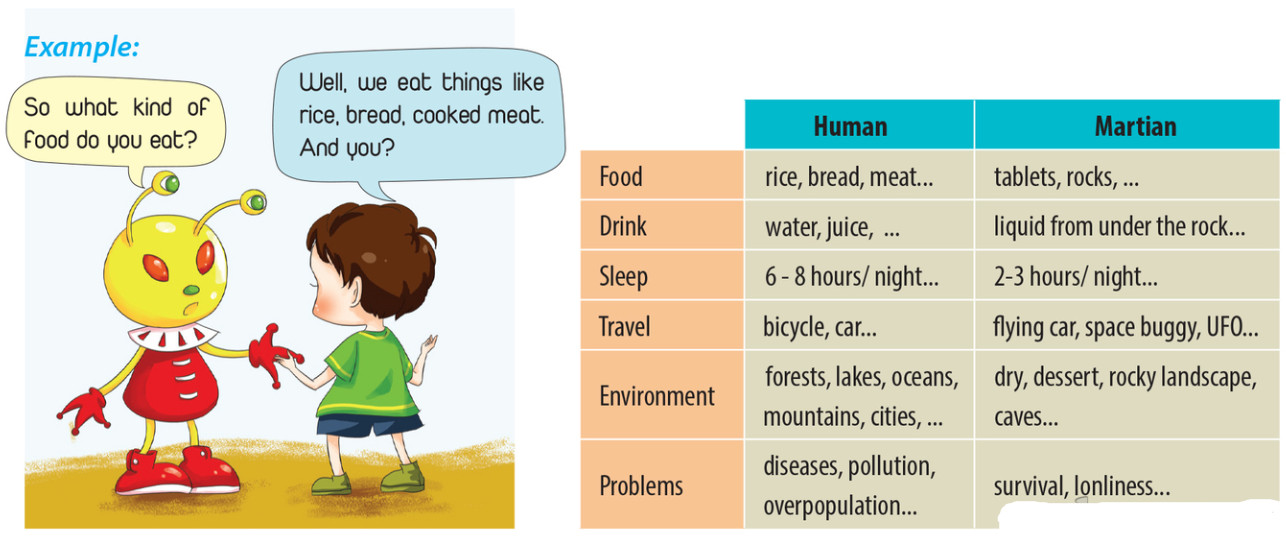Unit 12 lớp 8: Life On Other Planets - Skills 1
Phần Skills 1 - Unit 12 giúp các em rèn luyện hai kĩ năng quan trọng Reading và Speaking. Bài học giới thiệu bài đọc về saoo Hỏa và đưa ra các bài tập liên quan, sau đó hướng dẫn các em hỏi đáp về cuộc sống trên sao Hỏa và trên Trái đất. Mời các em đến với bài học bên dưới để thực hành hai kĩ năng này!
Mục lục nội dung

1. Reading
1.1. Task 1 Unit 12 lớp 8
a. Look at the pictures and discuss the questions. (Nhìn vào hình và thảo luận câu hỏi.)

1. What are the names of the two planets in pictures A and B?
(Tên của hai hành tình trong hình là gì?)
2. How do you think the pictures are different?
(Bạn nghĩ rằng những hình ảnh khác nhau như thế nào?)
Guide to answer
1. A. Earth (Trái đất)
B. Mars (sao Hỏa)
2. Totally different. (Hoàn toàn khác nhau.)
b. Read the text below and check your answers. (Đọc bài văn bên dưới và kiểm tra câu trả lời của em.)

Tạm dịch:
1. Sao Hỏa được gọi là hành tinh đỏ bởi vì bề mặt phủ đầy màu đỏ của nó. Có nhiều sự khám phá sao Hỏa bởi con người kể từ giữa thế kỷ 20. Các nhà khoa học hy vọng rằng chúng ta có thể tìm được một hành tinh khác để cung cấp nơi ở cho sự sống của con người.
2. Có nhiều lý do chính tại sao thời tiết trên sao Hỏa không phù hợp cho sự sống con người. Nhiệt độ trên sao Hỏa có thể xuống thấp đến mức -87 độ C và hiếm khi trên 0 độ c. Nhưng vấn đề lớn hơn là thiếu ôxi. 95% không khí là CO2 và đây là chất độc để hít thở. Hơn nữa, không có nước trên sao Hỏa mặc dù các nhà khoa học đã tìm được dấu vết của nó.
3. Tuy nhiên, đầu thế kỷ 19, các nhà khoa học đã khám phá ra rằng sao Hỏa có một vài điểm tương đồng với trái đất. Một ngày trên sao Hỏa là 24 giờ, 39 phút và 35 giây, gần bằng một ngày trên Trái đất. Sao Hỏa cũng trải qua các mùa như Trái đất. Tuy nhiên, các mùa này dài gấp đôi bởi vì một năm trên sao Hỏa kéo dài gấp đôi năm ở Trái đất.
1.2. Task 2 Unit 12 lớp 8
Find words in the text that have similar meanings to these words or phrases. (Tìm những từ trong bài văn mà có ý nghĩa tương tự với những hoặc cụm từ này.)

Guide to answer
1. causing death or illness = poisonous (tử vong hoặc bệnh tật = độc)
2. two times = twice (hai lần = gấp đôi)
3. has, goes through = experiences (có, trải qua = trải nghiệm)
4. marks or signs showing that something happened = traces (dấu hiệu hoặc đặc điểm cho thấy có điều gì đó đã xảy ra = dấu vết)
5. the outside or top layer of something = surface (lớp bên ngoài hoặc trên cùng của một cái gì đó = bề mặt)
6. weather conditions of a particular place = climate (điều kiện thời tiết của một địa điểm cụ thể = khí hậu)
7. provide a place to live = accommodate (cung cấp một nơi để sống = cung cấp)
1.3. Task 3 Unit 12 lớp 8
Match the headings with the paragraphs (1-3). There is one extra. (Nối tựa đề với những đoạn văn (1-3). Có một câu dư.)

Guide to answer
1.C. Explanation for the name of the Mars. (Giải thích tên của sao Hoả.)
2.B. Reasons why we may not be able to live on Mars.
(Những lý do tại sao chúng ta có thể không thể sống trên sao Hỏa.)
3.A. Reasons why we may be able to live on Mars.
(Những lý do tại sao chúng ta có thể sống trên sao Hỏa.)
1.4. Task 4 Unit 12 lớp 8
Read the text again and answer the questions. (Đọc bài văn lần nữa và trả lời câu hỏi.)
1. What is the other name for Mars? (Tên khác của sao Hỏa là gì?)
2. What are the lowest and the highest temperatures on Mars?
(Nhiệt độ cao nhất và thấp nhất trên sao Hỏa?)
3. Why is it poisonous to live on Mars? (Tại sao thật độc hại khi sống trên sao Hỏa?)
4. Which is longer, a day on Earth or a day on Mars ?
(Cái nào dài hơn, một ngày trên trái đất hay một ngày trên sao Hỏa?)
5. How long is a year on Mars? (Một năm trên sao Hỏa dài bao nhiêu?)
Guide to answer
1. It is also called the Red Planet. (Nó cũng được gọi là hành tinh đỏ.)
2. The lowest temperature is -87 degrees Celsius and the highest may be a bit higher than zero.
(Nhiệt độ thấp nhất là -87 độ C và nhiệt độ cao nhất là hơn 0 độ một chút.)
3. Because 95% of atmosohere is carbon dioxide. (Bởi vì 95% không khí là CO2.)
4. A day on Mars is a bit longer. (Một ngày trên sao Hỏa thì dài hơn một chút.)
5. It is twice as long as a year on Earth. (Nó dài gấp đôi một năm trên Trái đất.)
2. Speaking
2.1. Task 5 Unit 12 lớp 8
Work in pairs. One is a human and the other is a Martian. Use the suggestions below to ask and answer about life on Earth and life on Mars. (Làm theo cặp. Một là con người và người kia là người trên sao Hỏa. Sử dụng để nghị bên dưới để hỏi và trả lời về sự sống trên Trái đất và trên sao Hỏa.)

Example
- So what kind of food do you eat? (Vậy bạn ăn thức ăn gì? )
- Well, we eat things like rice, bread, cooked meat. And you? (Ồ, chúng mình ăn những thứ như cơm, bánh mì, thịt nấu chín. Còn bạn? )
Guide to answer
A: We eat tablets, rocks... What do you drink?
(Chúng mình ăn viên nén, những viên đá... Bạn uống gi? )
B: We drink water, juice... And you? (Chúng mình uống nước, nước ép... Còn bạn? )
A: We drink liquid from under the rock... How long do you sleep?
(Chúng mình uống chất lỏng từ dưới đất... Bạn ngủ trong bao lâu? )
B: We sleep for 6-8 hours/ night. And you? (Chúng mình ngủ trong 6-8 tiếng một đêm. Còn cậu? )
A: We sleep 2-3 hours/ night. How do you travel?
(Chúng mình ngủ 2-3 tiếng một đêm. Bạn đi lại như thế nào? )
B: We travel by bicycle, car... And you? (Chúng mình đi bằng xe đạp, xe hơi... Còn bạn? )
A: We travel by flying cars, space buggies, UFOs...
(Chúng mình đi bằng những xe bay, toa không gian, UFO... )
B: How is your environment? (Môi trường của bạn thế nào? )
A: The environment has forests, lakes, oceans. Moutains, cities... And you?
(Môi trường có rừng, hồ, đại dương, núi, thành phố... Còn bạn? )
B: We have dry dessert, rocky landspace, caves...What problem do you have ?
(Chúng mình có sa mạc khô hạn, cảnh núi non, hang động... Bạn có vấn đề gì? )
A: We have diseases, pollution, overpopulation... And you?
(Chúng mình có bệnh tật, ô nhiễm, đông dân số... Còn bạn? )
B: We have survival, loneliness....
(Chúng mình có sự sống còn, sự cô đơn...)
2.2. Task 6 Unit 12 lớp 8
Now swap pairs. The human of one pair works with the Martian of the other pair. Take turns to report what your previous partner said about life on their planet to your new partner to see if he/ she said similar things. (Bây giờ trao đổi theo cặp. Con người làm một cặp làm việc với người trên sao Hỏa là cặp khác. Lần lượt báo cáo với bạn học trước những gì đã nói về cuộc sống trên hành tinh của họ cho bạn mới của em để xem cậu ấy/ cô ấy nói điều tương tự không.)
3. Practice Task 1
Read the passage below and decide whether the statements are TRUE or FALSE?
Long ago, people thought the Moon was a god and we would never be able to reach it. However, the invention of telescopes in 1608 enabled people to learn that the Moon is just another planetary body. And mankind’s dream of walking on the Moon suddenly seemed possible.
The dream came true on July 20th, 1969 when Neil Armstrong, Buzz Aldrin, and Michael Collins flew to the Moon as part of the Apollo 11 lunar mission. Neil Armstrong was the first to step onto the Moon. After admiring the tranquil, desolate beauty of the Moon’s surface, Neil Armstrong and Buzz Aldrin completed their mission, while Collins stayed in orbit to maintain the systems on board the spacecraft.
During the stay of more than twenty-one hours on the Moon’s surface, the astronauts found no rain or wind at all. The Moon was like a desert with plains, mountains, and valleys. The surface was covered with dust, which was so thick that they left footprints where they had walked. They left a United States of America flag there and return to Earth with forty-six pounds of moon rock for scientific study.
Question 1: People have known all about the Moon for thousands years
Question 2: The invention of telescopes helped people to understand that the Moon is not a god.
Question 3: Only Neil Armstrong and Buzz Aldrin stepped onto the Moon.
Question 4: The climate on the Moon was unfriendly, with a lot of rain and wind
Question 5: The astronauts stayed on the Moon for nearly one day
4. Practice Task 2
Choose the letter A, B, C or D to answer these following questions
A new study published in the journal Science shows definitive evidence of organic matter on the surface of Mars. The data was collected by NASA's nuclear-powered rover Curiosity. It confirms earlier findings that Mars, the Red Planet once contained carbon-based compounds. These compounds – also called organic molecules – are essential ingredients for life as scientists understand it.
The organic molecules were found in Mars's Gale Crater, a large area that may have been a watery lake over three billion years ago. The rover encountered traces of the molecule in rocks extracted from the area. The rocks also contain sulfur, which scientists speculate helped preserve the organics even when the rocks were exposed to the harsh radiation on the surface of the planet.
Scientists are quick to state that the presence of these organic molecules is not sufficient evidence for ancient life on Mars, as the molecules could have been formed by non-living processes. But it's still one of the most astonishing discoveries, which could lead to future revelations. Especially when one considers the other startling find that Curiosity uncovered around five years ago.
Question 1: Did Mars contain carbon-based compounds?
A. Yes, it did B. no, it didn’t
Question 2: What may have been in Mars's Gale Crater?
A. a mountain B. a forest C. a lake D. a hill
Question 3: What was the role of sulfur in the rocks?
A. It helped preserve the organics B. It formed the rocks
C. It made the atmosphere D. It made life possible
Question 4: Have there been enough evidences to confirm the existence of life on Mars?
A. Yes, there have B. No, there haven’t
Question 5: Why are the evidences in sufficient to claim life on Mars?
A. The molecules could have been formed by non-living processes.
B. The molecules exist everywhere on the planet.
C. All planets have these molecules.
D. The existence of these molecules is not strong enough
5. Conclusion
Kết thúc bài học, các em cần đọc lại bài viết về sao Hỏa và những điểm giống và khác với Trái đất, tập hỏi và trả lời về cuộc sống trên sao Hỏa và trên Trái đất; đồng thời ghi nhớ các từ vựng sau:
- poisonous (adj): nhiễm độc
- experiences (n): trải nghiệm
- traces (n): dấu vết
- climate (n): khí hậu
- accommodate (v): thích nghi
- surface (n): bề mặt
Tham khảo thêm
- doc Unit 12 lớp 8: Life On Other Planets - Getting Started
- doc Unit 12 lớp 8: Life On Other Planets - A Closer Look 1
- doc Unit 12 lớp 8: Life On Other Planets - A Closer Look 2
- doc Unit 12 lớp 8: Life On Other Planets - Communication
- doc Unit 12 lớp 8: Life On Other Planets - Skills 2
- doc Unit 12 lớp 8: Life On Other Planets - Looking Back
- doc Unit 12 lớp 8: Life On Other Planets - Project
